Unlocking Your Urban Oasis
Your balcony, a blank canvas of possibility, can transform into a thriving garden escape with the right ideas. Let’s explore 10 lush apartment balcony garden designs tailored for plant enthusiasts like you. Start with vertical greenery using wall-mounted planters (12” x 24”) for herbs like thyme; then, consider tropical monstera in 10-gallon pots. Curious how to maximize every inch? Stick around for practical, space-saving tips.
Contents
- 1 Vertical Greenery for Small Spaces
- 2 Herb Haven on Your Balcony
- 3 Tropical Vibes With Bold Foliage
- 4 Minimalist Plant Nook Design
- 5 Colorful Flower Displays
- 6 Succulent Sanctuary Setup
- 7 Cozy Corner With Climbing Vines
- 8 Edible Garden in Tight Quarters
- 9 Zen Retreat With Bamboo Accents
- 10 Mixed Container Planting Ideas
Vertical Greenery for Small Spaces
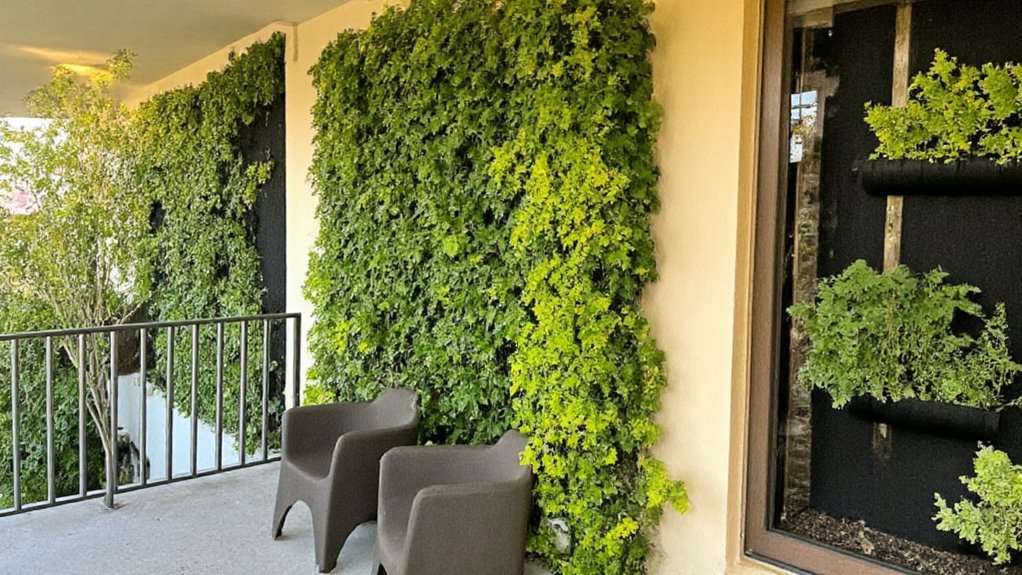
Vertical greenery is an innovative solution for apartment dwellers with limited balcony space, allowing them to maximize their gardening potential by utilizing wall space. By installing structures like wall-mounted planters, trellises, or vertical garden systems, residents can grow a variety of plants such as herbs, flowers, or even small vegetables without cluttering the floor area. These setups not only save space but also add a striking visual element, transforming bare walls into lush, green focal points.
This approach is particularly effective for small balconies where traditional pots and containers might overwhelm the area. Vertical gardens can be customized to fit any style or budget, using DIY solutions like repurposed pallets or store-bought modular systems, and they often require minimal maintenance if paired with self-watering mechanisms. This makes vertical greenery an accessible and practical way to bring nature into compact urban living spaces.
Herb Haven on Your Balcony
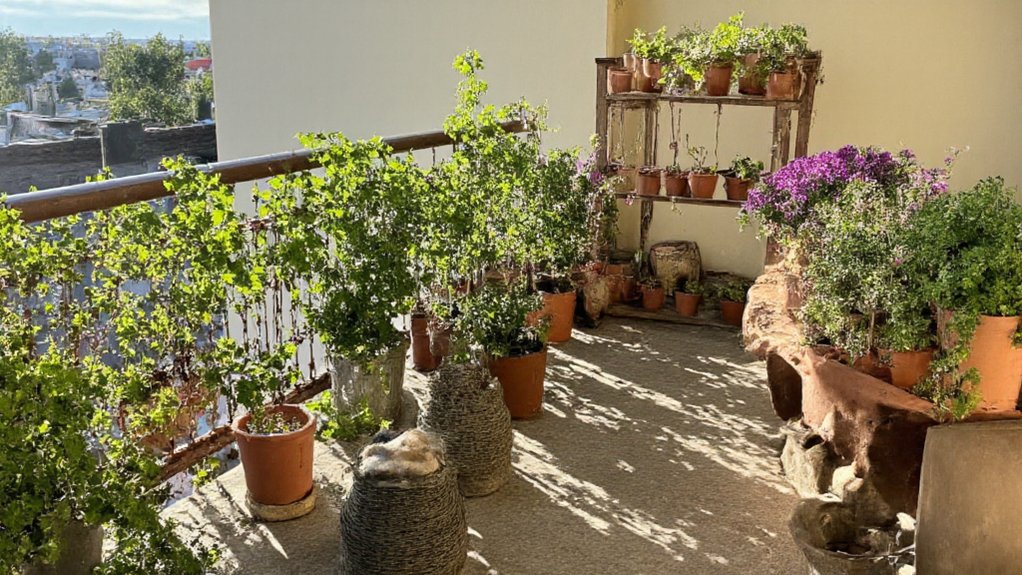
Creating a herb haven on your balcony is a delightful way to bring fresh flavors and greenery into your urban space. Herbs like basil, mint, thyme, and rosemary are perfect for small-scale gardening as they thrive in containers and require minimal space. With just a few pots or a vertical planter, you can cultivate a variety of herbs that not only enhance your cooking but also add a fragrant, aesthetic touch to your balcony.
To start, choose a sunny spot on your balcony since most herbs need at least 6 hours of sunlight daily. Use well-draining soil and pots with drainage holes to prevent waterlogging, and consider grouping herbs with similar water and light needs together. Regular watering and occasional pruning will keep your herb garden flourishing, providing you with a steady supply of fresh ingredients right at your fingertips.
Tropical Vibes With Bold Foliage
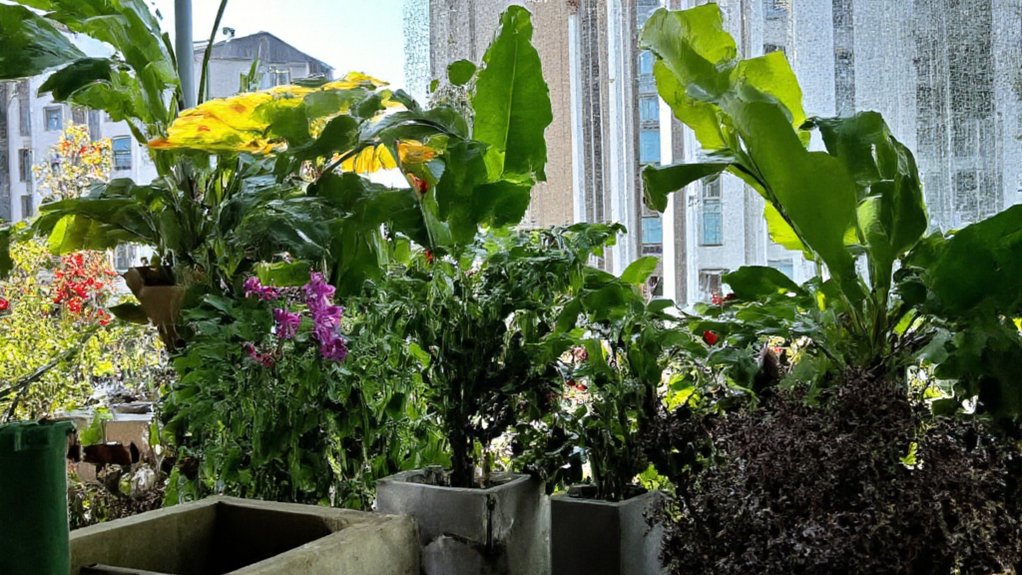
Creating a tropical vibe on your apartment balcony with bold foliage is an excellent way to transform a small outdoor space into a lush, exotic retreat. Opt for plants with large, vibrant leaves such as monstera, bird of paradise, or elephant ear, which instantly evoke the feel of a tropical jungle. These plants thrive in warm, humid conditions, so make sure they receive ample indirect sunlight and regular watering to mimic their natural habitat.
To enhance the tropical aesthetic, layer different heights and textures by combining tall, statement plants with shorter, bushy ones like ferns or calatheas. Add colorful accents with flowering plants such as hibiscus or bromeliads to bring pops of color against the rich green backdrop. With the right care, your balcony can become a mini oasis that transports you to a faraway island getaway.
Minimalist Plant Nook Design
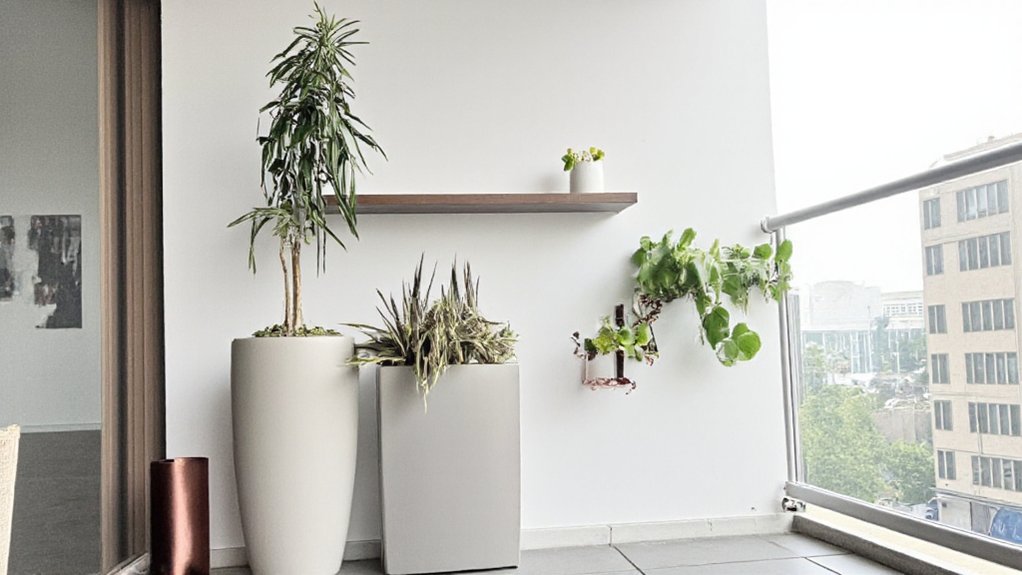
A minimalist plant nook design for an apartment balcony focuses on creating a serene, uncluttered space that maximizes greenery with simplicity. This approach often involves selecting a small corner or section of the balcony to dedicate to plants, using clean lines and neutral tones in pots or planters to maintain a cohesive, calming aesthetic. Opt for a limited number of plants with varying heights and textures, such as a tall leafy fern paired with a low succulent, to add visual interest without overwhelming the space.
Key elements include wall-mounted shelves or vertical planters to save floor space, and choosing low-maintenance plants that thrive in balcony conditions, like pothos or snake plants. Incorporate natural materials like wood or ceramic for containers, and consider a small seating area nearby to enjoy the nook as a peaceful retreat. This design guarantees the balcony remains functional while transforming a small area into a green oasis.
Colorful Flower Displays
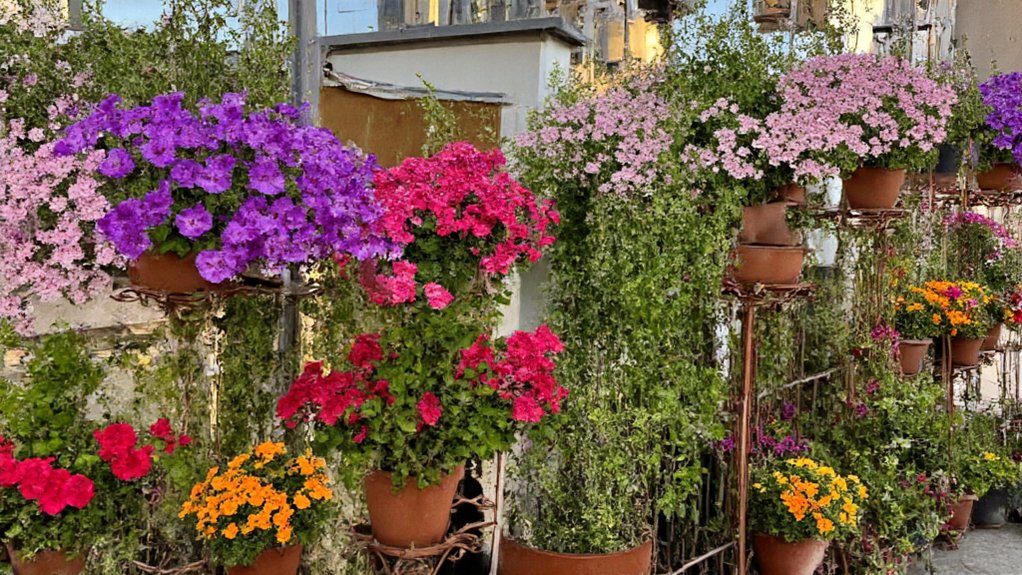
Colorful flower displays can transform an apartment balcony into a vibrant oasis, adding beauty and life to a small outdoor space. By selecting a variety of flowering plants with different bloom times, such as petunias, marigolds, and geraniums, you can guarantee a continuous burst of color throughout the seasons. Hanging baskets, railing planters, and tiered stands are excellent ways to maximize limited space while creating a stunning visual impact.
When choosing flowers, consider the amount of sunlight your balcony receives and opt for species that thrive in those conditions. Pairing bold hues like red and yellow with softer tones like pink and white can create a balanced and eye-catching arrangement. Additionally, incorporating foliage plants or vines can add texture and depth, enhancing the overall appeal of your balcony garden.
Succulent Sanctuary Setup
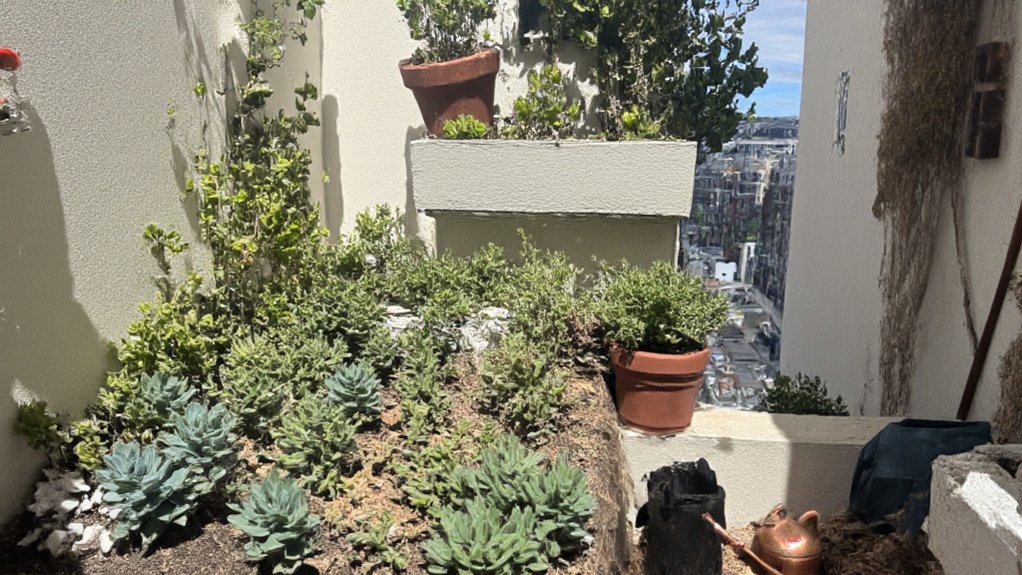
Creating a Succulent Sanctuary on your apartment balcony is an ideal way to bring low-maintenance greenery into your urban space. Succulents are hardy plants that thrive in small areas with minimal care, making them perfect for balcony gardens. To set up your sanctuary, choose a sunny spot on your balcony, as most succulents require at least 4-6 hours of direct sunlight daily. Select a variety of succulents with different shapes, sizes, and colors—such as echeveria, sedum, or aloe—to create visual interest.
Start by using well-draining containers or shallow pots with drainage holes to prevent root rot, and fill them with a specialized succulent or cactus potting mix. Arrange the plants thoughtfully, grouping taller varieties in the back and smaller ones in the front for a balanced look. Add decorative elements like pebbles, gravel, or small rocks to enhance the aesthetic and mimic their natural desert habitat. Water sparingly, only when the soil is completely dry, and maintain proper air circulation to keep your succulents healthy in the confined balcony environment.
Cozy Corner With Climbing Vines
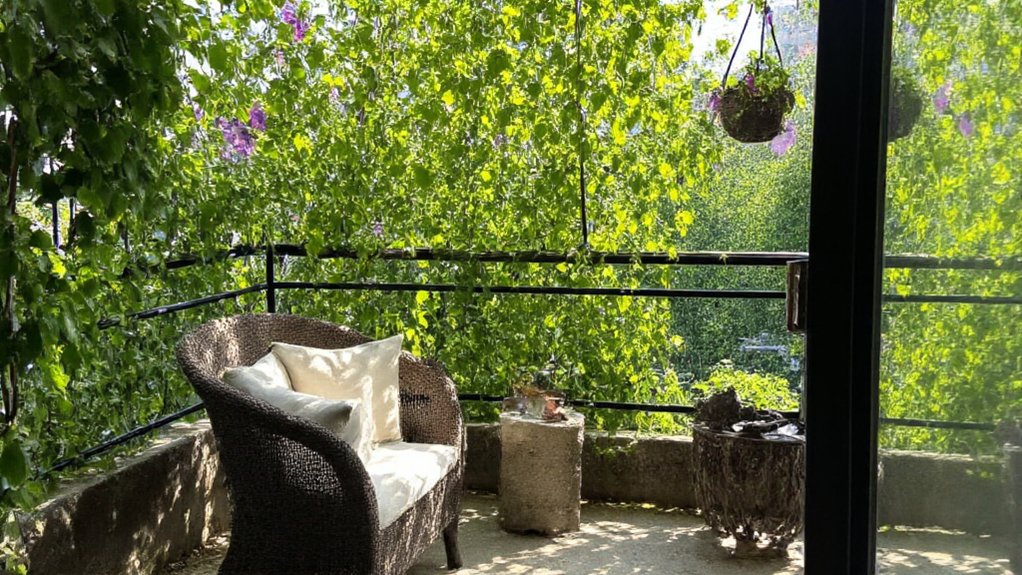
Creating a cozy corner with climbing vines on your apartment balcony can transform a small space into a lush, private retreat. Choose a corner of your balcony where you can place a comfortable chair or a small bench, and install a trellis or a set of wall-mounted supports for the vines to climb. Opt for fast-growing, low-maintenance vines like ivy, clematis, or morning glory, which can quickly cover the structure and provide a natural green wall that adds both beauty and shade.
To enhance the coziness, add soft cushions, a small side table for your coffee or books, and perhaps a few hanging lanterns or string lights for ambiance in the evening. Make sure the vines are well-watered and pruned regularly to maintain their shape and prevent overgrowth. This setup not only maximizes limited balcony space but also creates a serene nook where you can unwind amidst nature.
Edible Garden in Tight Quarters
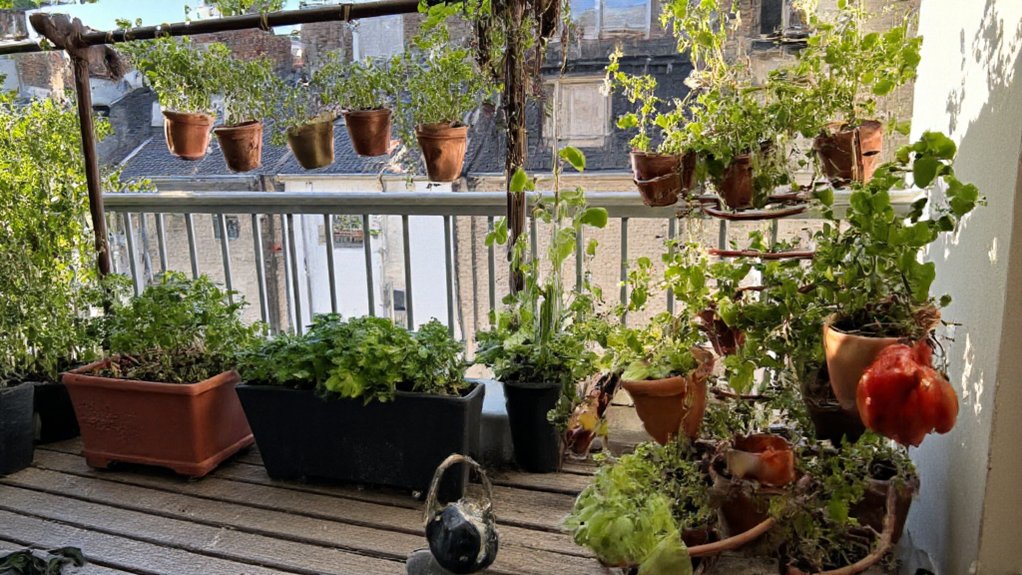
Creating an edible garden in tight quarters like an apartment balcony is not only possible but also incredibly rewarding. With limited space, you can grow a variety of herbs, vegetables, and even small fruits using containers, vertical planters, or hanging baskets. Opt for compact or dwarf varieties of plants such as cherry tomatoes, lettuce, spinach, basil, and peppers, which thrive in small spaces and require minimal room to grow. Make sure your balcony gets at least 6 hours of sunlight daily, as most edible plants need ample light to produce a good yield.
To maximize space, consider tiered plant stands or wall-mounted planters to grow more without cluttering the floor area. Use well-draining pots with quality potting soil and make sure proper watering, as container gardens can dry out quickly. Companion planting, like pairing basil with tomatoes, can also help save space and improve growth. With a little planning and care, your balcony can become a mini oasis of fresh, homegrown produce, even in the smallest of spaces.
Zen Retreat With Bamboo Accents
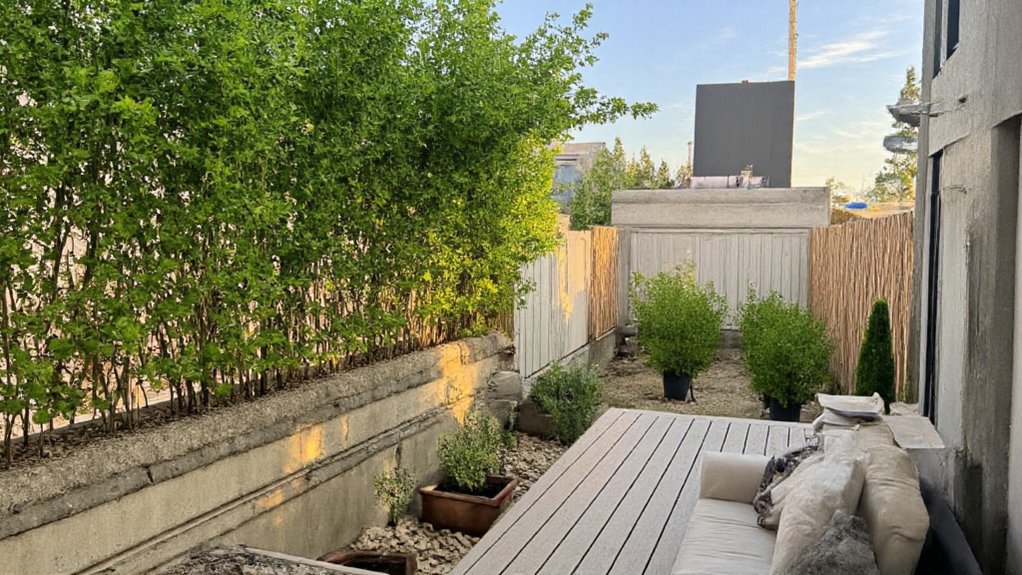
Creating a Zen retreat on your apartment balcony with bamboo accents can transform a small outdoor space into a serene escape. Bamboo, with its natural elegance and calming presence, serves as a perfect element for fostering tranquility. Incorporate bamboo plants in tall, sleek planters or use bamboo screens to create a private, peaceful nook shielded from the outside world. The gentle rustling of bamboo leaves in the breeze adds a soothing auditory element, enhancing the meditative atmosphere.
To complete the Zen vibe, pair the bamboo with minimalist decor such as smooth river rocks, a small water feature, or a simple wooden bench for quiet reflection. Opt for neutral tones and natural materials to maintain a clutter-free, harmonious look. Soft lighting, like lanterns or string lights, can further elevate the calming ambiance, making your balcony a perfect spot for mindfulness and relaxation amidst the hustle of urban life.
Mixed Container Planting Ideas

Mixed container planting is a fantastic way to maximize the limited space of an apartment balcony while creating a vibrant and diverse garden. By combining different plants in a single container, you can achieve a dynamic display of colors, textures, and heights that adds visual interest. Choose plants with complementary needs for sunlight, water, and soil type to make sure they thrive together, such as pairing trailing vines like ivy with upright plants like geraniums or small shrubs.
Consider incorporating a mix of annuals, perennials, and even herbs or small vegetables for both aesthetic appeal and functionality. For example, a container with bright marigolds, aromatic basil, and cascading petunias can serve as both a decorative piece and a practical herb garden. Experiment with varying pot sizes and shapes to create depth, and don’t forget to layer plants by placing taller ones at the back or center and shorter or trailing ones around the edges for a balanced look.
